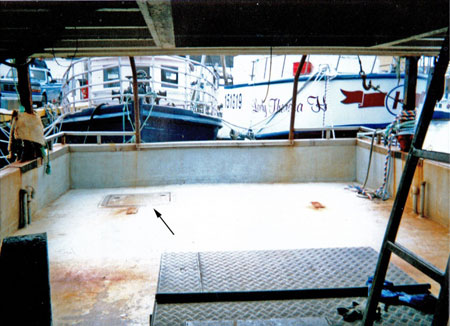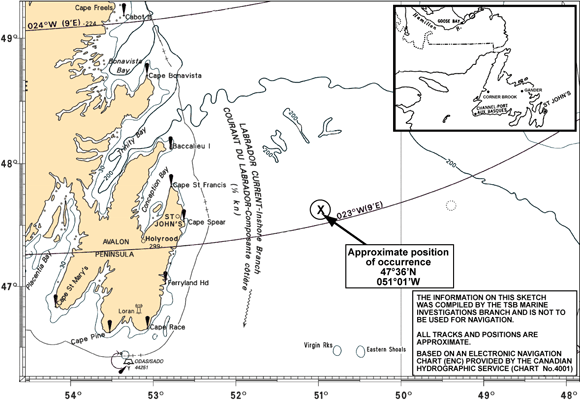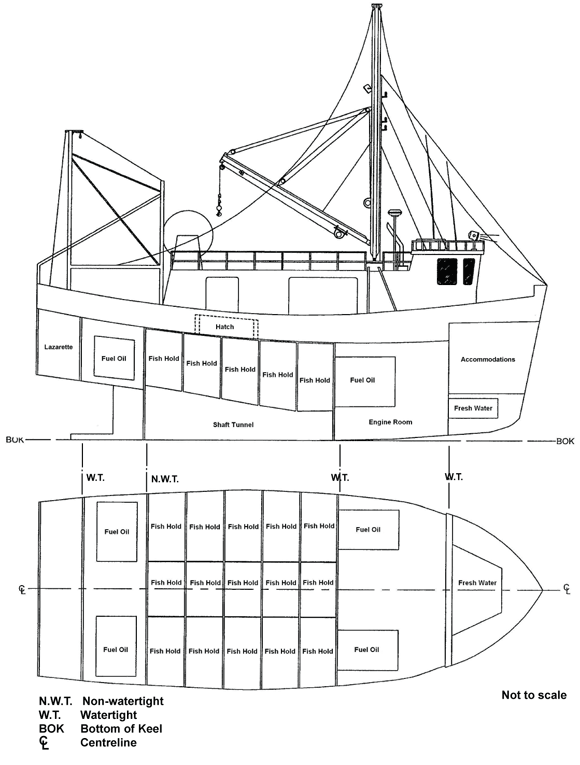Taking on water and sinking
Small fishing vessel Sea Gypsy Enterprises
67 nm East of Cape Spear, Newfoundland and Labrador
The Transportation Safety Board of Canada (TSB) investigated this occurrence for the purpose of advancing transportation safety. It is not the function of the Board to assign fault or determine civil or criminal liability. This report is not created for use in the context of legal, disciplinary or other proceedings. See Ownership and use of content. Masculine pronouns and position titles may be used to signify all genders to comply with the Canadian Transportation Accident Investigation and Safety Board Act (S.C. 1989, c. 3).
Summary
On the morning of 12 September 2009, at approximately 1129, the small fishing vessel Sea Gypsy Enterprises, with five crew members on board, capsized and later sank approximately 60 nautical miles east of Cape Spear, Newfoundland and Labrador. Three crew members were rescued, and the body of a fourth was recovered by a Department of National Defence search and rescue helicopter. The fifth crew member is still missing.
Factual information
Particulars of the vessel
| Name of vessel | Sea Gypsy Enterprises |
|---|---|
| Registry/Licence number | 819127 |
| Port of registry | St. John's, Newfoundland and Labrador |
| Flag | Canada |
| Type | Small fishing vessel |
| Gross tonnage | 63 |
| Registered lengthFootnote 1 | 13.91 m |
| Draught | Forward : 1.3 m Aft: 3.2 m |
| Built | 1996, Clark's Harbour, Nova Scotia |
| Propulsion | One Cummins diesel engine developing 373 kW, single propeller |
| Cargo | Shrimp (30 200 kg) |
| Crew | 5 |
Description of the vessel
The Sea Gypsy Enterprises was a small fishing vessel of the Cape Island design of closed construction, built in moulded, glass-reinforced plastic, with the wheelhouse and accommodation forward, and the engine compartment beneath the wheelhouse. The hull below the main deck was subdivided by four transverse bulkheads that enclosed (from forward) the crew accommodation space, the engine room, a fish hold, the steering gear compartment, and the lazarette (see Appendix B). Of the four bulkheads, only the bulkhead between the fish hold and the steering gear compartment was not watertight.Footnote 2
The vessel was powered by a marine diesel engine with a reverse/reduction gearbox driving a single fixed-pitch propeller and was fitted with a single plate centreline rudder. A propeller shaft packing gland designed to prevent the entry of water into the engine room was fitted in way of the bulkhead between the shaft tunnel and engine room; however, it was not unusual for the packing gland to leak. Four diesel tanks were arranged on the port and starboard sides of the engine room and the lazarette. A fresh water tank was located in the forepeak.
The working deck was aft, surrounded by a solid bulwark forming a well. Entry to the wheelhouse was through a hinged door on the starboard side, and access to the engine compartment was through a door on deck. The only entry into the steering gear compartment was through a hinged watertight door on the after fish hold bulkhead.
The working deck had a single raised hatch located along the centreline, which provided access to the fish hold. A single flush watertight hatch that provided access to the lazarette was fitted on the starboard quarter of the main deck. The hatch was covered with an aluminum watertight cover fitted with a series of six dogs that could be tightened or loosened with a socket wrench. A series of scuppers (four on each side) were located in the bulwark at deck level on each side.
The vessel was fitted with an engine-driven bilge and fire pump. The bilge main piping system was fitted with direct suctions to the accommodations, engine room, and the fish hold. Additionally, submersible electric bilge pumps were fitted in the engine room, fish hold,Footnote 3 and lazarette.
The Sea Gypsy Enterprises was originally constructed as a 50-foot vessel, but in 2000, the owners hired a naval architect firm to develop a lines plan for the vessel. In 2002, a four-foot extension in the form of a lazarette was added to the stern. The lengthening of the vessel was done according to plans approved by Transport Canada (TC). The vessel was also subject to TC inspection.
The vessel was inclined in September 2008, and a stability book was produced in January 2009.Footnote 4 However, a review of the book showed that the stability calculations were based on the original 50-foot length, although the vessel was now 54 feet in length.Footnote 5
History of the voyage
On the evening of 07 September 2009, the Sea Gypsy Enterprises, with a crew of five, departed Port de Grave, Newfoundland and Labrador, to fish for shrimp. The vessel arrived at the fishing grounds on the morning of September 9, and commenced fishing. By the afternoon of September 11, the fish hold was filled with an estimated 29 200 kg of shrimp (placed in bags) and 4000 kg of ice. Approximately 450 kg of shrimp were stowed on deck and a further 560 kg on the upper deck aft of the wheelhouse. The return voyage was uneventful until about 1109Footnote 6 on September 12. Then, over the next 15 minutes, the vessel's speed dropped from 6.2 knots to 4.0 knots. The master was notified. At this time water was coming over the bulwarks.
At about the same time, it was noted that the hatch cover for the lazarette, which had not been secured, had become dislodged and was lying diagonally across the opening. It was also noted that the lazarette was completely flooded.Footnote 7 Two crew members put the hatch cover in place but were unable to secure it using the dogs. Instead, they kept it in place by standing on the cover. Meanwhile, the bilge pump for the lazarette was started. No water was noticed leaking into the engine room from the propeller shaft packing gland in way of the engine room aft bulkhead.
At about that time, the rudder angle indicator on the bridge stopped functioning (the feedback unit for the indicator was located in the steering gear compartment). With the bilge pump unable to keep up with the ingress of water, four crew members donned immersion suits. Two crew members then proceeded to the wheelhouse top and launched the port liferaft. The master, meanwhile, notified Marine Communications and Traffic Services St. John's and declared a MAYDAY at 1109. Marine Communications and Traffic Services immediately issued a MAYDAY Relay.
The vessel then capsized, with at least four of the five crew members escaping as it did so. The master, who had not donned an immersion suit, swam to and boarded the liferaft. However, because the painter was caught up in the rigging and the master was unable to locate the liferaft's knife to cut the painter, he abandoned the liferaft and swam to the starboard liferaft capsule. This liferaft, which was fitted with a hydrostatic release, had deployed, but had not inflated. Pulling on the painter, the master inflated the liferaft and then boarded the raft. Concerned that the liferaft would sink with the vessel, he used the liferaft's knife to cut the painter. The raft then drifted away with the master alone on board. The remaining crew members were unable to board either liferaft.
About 20 minutes after the vessel capsized, it sank in position 47°36′N, 051°01′W.
Search and rescue
After the MAYDAY Relay and the vessel's subsequent capsizing, an EPIRB (emergency position-indicating radio beacon) signal was detected and continued for 2 hours and 56 minutes.
At 1114, Joint Rescue Coordination Centre Halifax began tasking several resources. These included two Cormorant helicopters and two Hercules aircraft from Department of National Defence squadrons in Gander, Newfoundland and Labrador, and Greenwood, Nova Scotia, respectively. Two small commercial aircraft were also tasked, the first from approximately 170 km away, and a second several hours later from St. John's, Newfoundland and Labrador.
One of the commercial aircraft was first to arrive on scene at 1151, and by 1450, one of the helicopters had rescued the master and two crew members and recovered the body of a third crew member.
Search and rescue efforts continued until 2200 on 14 September 2009, at which time operations were terminated and the case was turned over to the Royal Canadian Mounted Police.
Damage to the vessel
The overturned vessel remained afloat for only a short while before it sank. It was not recovered.
There was no apparent pollution.
Injuries to persons
The master and two crew members suffered mild hypothermia. One crew member died, and a fifth is missing.
Vessel certification
The Sea Gypsy Enterprises was last inspected by TC on 14 April 2009, when an inspection certificate was issued for a non-passenger vessel exceeding 15 tons but not exceeding 150 tons. The certificate, which was due to expire on 13 April 2013, allowed the vessel to operate on voyages up to Near Coastal Voyage, Class I.
Personnel certification and experience
The master held a Fishing Master III certificate. He had 16 years' experience fishing, including 12 as master.
The crew member on watch at the beginning of the occurrence held a Fishing Master II certificate and had nine years of experience fishing.
All five crew members had marine emergency duties training.
Weather and sea conditions
At the time of the occurrence, winds were northwest at between 20 knots and 25 knots. Air and sea temperatures were 11°C and 9°C respectively. Seas were 3 m, and visibility was from 10 to 12 miles.
Lifesaving equipment
Lifesaving equipment aboard the Sea Gypsy Enterprises included eight lifejackets, eight immersion suits, a twelve-person liferaft with a hydrostatic release, an eight-person liferaft with a hydrostatic release, two lifebuoys, and one float-free EPIRB.
Proposed requirements for high bilge level alarm devices
As a result of its investigation into the swamping and sinking of the small fishing vessel Brier Mist in 1998, the Board issued a safety concern about the lack of progress on the installation of water level detection and alarm systems in compartments below the water level. Furthermore, the coroner's inquest into the deaths of the five crew of the Brier Mist recommended to TC that similar fishing vessels "be fitted with a water level detector in the fish holds."
TC indicated that it agreed and stated that a Small Fishing Vessel Steering Committee would examine the subject. As of 2010, this coroner's recommendation has not been implemented.
At the spring 2009 meeting of the Canadian Marine Advisory Council, TC presented an information paper, Draft Fishing Vessel Safety Regulations, for public consultation. The paper contains a proposal that all fishing vessels, except where the bilge can be readily seen, be fitted with a high bilge level alarm in each watertight compartment.
TC has stated that these draft regulations will likely be published in the Canada Gazette, Part I, in 2011.
Analysis
The safety of a vessel at sea depends on maintaining watertight integrity. It is important that measures such as closing access hatches and other openings be taken to prevent the ingress of water. It is also important that crews become aware of developing situations so that they can take early and appropriate action. The safety shortcomings related to these issues, as demonstrated in the present occurrence, are discussed in the subsections that follow.
Flooding scenario
The importance of ensuring that watertight hatches are properly secured while at sea cannot be overstated. Failure to secure hatches, except when they are necessarily opened for the working of the crew, places vessels at risk.
In this occurrence, the lazarette's hatch cover was in position but unsecured, held in place merely by its own weight. It was therefore not watertight and, as the vessel shipped seas, water would have downflooded into the lazarette. Calculations show that this water would have added approximately 13 tonnes of weight to the stern, reducing the vessel's freeboard by some 68 cm.
However, a flooded lazarette would not have been enough to sink the vessel on it own. Additional water would have been required-possibly entering the steering gear compartment via the rudder stock packing gland. The weight of the additional water in the lazarette would have also added to the after draft, which would in turn have increased the water pressure on the rudder stock packing gland, possibly causing it to leak or fail. Such upflooding would have further reduced the after draft, and when that compartment was flooded to near-capacity, the vessel would have achieved deck-edge immersion and significant loss of stability.
Given that the vessel was not recovered, this proposed scenario cannot be determined with certainty to have been the cause of the occurrence. Nonetheless, it remains the likeliest scenario, especially given that the rudder angle indicator-the feedback unit for the indicator being located in the steering gear compartment-stopped working shortly before the vessel sank. This malfunction suggests that water may have upflooded into the compartment. Furthermore, no water was seen leaking from the propeller shaft packing gland in way of the engine room aft bulkhead, which would suggest that the ingress of water was not draining into the shaft tunnel, but was accumulating in the steering gear compartment.
The issue of unsecured hatch covers has been addressed previously. In April 1998, TC issued Ship Safety Bulletin (SSB) 06/1998, Responsibilities of Shipowners and Masters Respecting Maintenance of Weathertight Integrity of their Vessels, reminding masters to ensure that hatch covers are closed at sea when necessary, and to make certain that openings to compartments within the hull are maintained closed except when in use.
Detection of water ingress / Access to key compartments
Early detection of water ingress is important to take timely action before a developing situation becomes an emergency. Even in instances in which ingress cannot be stemmed, early detection allows more time for abandonment, thereby increasing a crew's chance of survival. For compartments in which periodic inspection is impractical while underway (such as the steering gear compartment of this vessel), the installation of automatic pumps and high bilge level alarm devices are both an inexpensive and an effective crew alert. Ideally, each closed compartment below the waterline should have an alarm and a means of removing water.
Previous TSB investigations have recognized the dangers associated with undetected water ingress.Footnote 8 As a result, TC issued SSB 04/2000, Flooding Detection on Fishing Vessels, which "strongly recommends that water detectors (such as float switches, probes, etc.) be fitted in all 'dry' compartments located below the weather deck which are not subject to frequent visits, other than fish holds." The bulletin also recommends as an interim measure, and until water detectors are installed for dry compartments, that "monitoring rounds on every watch be added immediately to standing orders, to verify water levels and take ullages." In August 2002, TC issued another SSB-specifically, SSB 09/2002, Bilge Pumping Systems: Early Detection Saves Lives-to highlight the importance of bilge pumping systems, the early detection of any leakage, and what operators should be aware of and ensure.
In the present occurrence, there were no routine visual inspections of the lazarette, and therefore no one was aware of the water ingress until the stern was awash, and the lazarette full. Although the vessel was fitted with a high bilge level alarm in the engine room, no such alarms were installed elsewhere. Without the presence of alarms, early detection of water ingress in the lazarette and steering gear compartment was possible only by repeated visual inspections. Furthermore, access to the steering gear compartment was possible only via the fish hold-when the fish hold was full, the crew had no means to detect water ingress in the steering gear compartment.
Even if no upflooding into the steering gear compartment had occurred, a vessel whose design restricts access in the described manner presents additional risks. For example, should key equipment fail or something go wrong, restricted access to safety-critical compartments could lead to delays, wasting valuable time during an emergency. In this occurrence, the rudder angle indicator-the feedback unit for the indicator being located in the steering gear compartment-stopped working shortly before the vessel sank. This malfunction suggests that water had upflooded into the compartment. The crew, however, had no way to verify such upflooding.
Safety practices and procedures
The Canada Shipping Act, 2001, section 106(1) requires, and good seamanship dictates, the development of procedures for the safe operation of a vessel and for dealing with emergencies. Such procedures should include securing watertight hatches, maintaining equipment, and conducting safety drills so as to assist crews in identifying and managing risks to safety. In the present occurrence, the vessel departed the fishing grounds with the lazarette hatch unsecured, and the consequent downflooding was not noted until the situation had become critical.
In the absence of established safety practices and procedures, there is a risk that unsafe conditions will remain unidentified and unaddressed.
Findings
Findings as to causes and contributing factors
- The unsecured hatch cover permitted downflooding into the lazarette, thereby increasing the vessel's after draft.
- Without the benefit of an alarm or some other means to detect water ingress, the crew did not detect the flooding until it was too late.
- Additional water likely entered the steering gear compartment, possibly through the rudder stock packing gland.
Findings as to risk
- Safety-critical compartments that cannot be directly accessed at all times during a voyage may place vessels and crews at risk during an emergency.
- In the absence of established safety practices and procedures, there is a risk that unsafe conditions will remain unidentified and unaddressed.
This report concludes the Transportation Safety Board's investigation into this occurrence. Consequently, the Board authorized the release of this report on .



